| Hood-leaved hakea | |
|---|---|
_01.JPG.webp) | |
| H. cucullata in Waychinicup National Park. | |
| Scientific classification | |
| Kingdom: | Plantae |
| Clade: | Tracheophytes |
| Clade: | Angiosperms |
| Clade: | Eudicots |
| Order: | Proteales |
| Family: | Proteaceae |
| Genus: | Hakea |
| Species: | H. cucullata |
| Binomial name | |
| Hakea cucullata | |
 | |
| Occurrence data from Australasian Virtual Herbarium | |
| Synonyms[1] | |
| |
Hakea cucullata, commonly known as hood-leaved hakea, cup hakea or scallop hakea,[2] is a species of shrub in the family Proteaceae and is endemic to the south-west of Western Australia. It is an attractive shrub with distinctive foliage and beautiful large pink, red, or deep purple scented flowers.
Description
Hakea cucullata is an erect shrub growing to a height of 1–5 metres (3–20 ft) with few branches. The young branches are densely covered with short hairs and the flowering stems have dark brown hairs. The leathery leaves are broad egg-shaped 37–75 millimetres (1–3 in) long and 38–90 millimetres (1–4 in) wide. Often with wavy or finely toothed margins and a prominent mid-vein ending in a point at the apex. The leaves are pale green in colour, more or less overlap, distinctly cupped around the stem, flowers and fruit. The inflorescence consists of 25 to 30 deep pink flowers appearing in the leaf axils or at leafless nodes on bright pink stalks 5.5–8 millimetres (0.2–0.3 in) long. The perianth is deep pink at the base paler toward the tip. The pedicels are 5.5–8 mm (0.22–0.31 in) long and smooth. The style is smooth, straight and 17–25 mm (0.67–0.98 in) long. Flowering mainly occurs from August to October. The woody egg-shaped fruit are 2.2–2.8 cm (0.87–1.1 in) long and 1.4–2.0 cm (0.55–0.79 in) wide in groups of 1-5 in leaf axils.[3][4][5][6][7]
Taxonomy and naming
Hakea cucullata was first described by Robert Brown in 1830 from a specimen collected by William Baxter in 1824 and the description was published in Supplementum primum Prodromi florae Novae Hollandiae.[1][8] The specific epithet (cucullata) is derived from the Latin word cucullatus meaning "hooded".[9]
Distribution and habitat
Hood-leaved hakea is found in the Stirling Range, south-western Western Australia, east to the Whoogarup Range[3] in the Esperance Plains, Jarrah Forest and Warren biogeographic regions where it grows in sandy mallee heath and occasionally in gravelly lateritic soils.[4][5][10]
Conservation
Hakea cucullata is classified as "not threatened" by the Western Australian Government Department of Parks and Wildlife.[5]
Use in horticulture
Scallop hakea is reasonably hardy as a garden plant[11] and has been grown successfully on Kangaroo Island.[12] It is easily propagated from seed[11] and has been successfully grafted onto Hakea salicifolia root stock.[13]
References
- 1 2 3 "Hakea cucullata". APNI. Retrieved 23 February 2019.
- ↑ Young, Jennifer A. (2006). Hakeas of Western Australia:A Field and Identification Guide. J.A. Young. ISBN 0-9585778-2-X.
- 1 2 "Hakea cucullata". Government of South Australia Department of Water, the Environment and Water Resources. Retrieved 26 November 2015.
- 1 2 Wilson (ed), Annette; Barker, Robyn M.; Haegi, Laurence A.; Barker, William R. (1999). Flora of Australia. Canberra/Melbourne: ABRS-Department of Environment & Heritage. ISBN 0-643-06454-0.
{{cite book}}:|last1=has generic name (help) - 1 2 3 "Hakea cucullata R.Br". FloraBase. Western Australian Government Department of Biodiversity, Conservation and Attractions.
- ↑ "Hakea cucullata R.Br". Flora of Australia Online. Department of the Environment and Heritage, Australian Government.
- ↑ Wrigley, John W.; Fagg, Murray (1989). Banksias, Waratahs & Grevilleas & all other plants in the Australian Proteaceae family. Collins. ISBN 0-7322-0020-2.
- ↑ Brown, Robert (1830). Prodromus Florae Novae Hollandiae – First Supplement. London. p. 30. Retrieved 17 November 2015.
- ↑ Brown, Roland Wilbur (1956). The Composition of Scientific Words. Washington, D.C.: Smithsonian Institution Press. p. 241.
- ↑ Paczkowska, Grazyna; Chapman, Alex R. (2000). The Western Australian flora : a descriptive catalogue. Perth: Wildflower Society of Western Australia. p. 492. ISBN 0646402439.
- 1 2 Wrigley, John W.; Fagg, Murray (1983). Australian native plants : a manual for their propagation, cultivation and use in landscaping (2nd ed.). Sydney: Collins. pp. 236–238. ISBN 0002165759.
- ↑ "Fact Sheet: Stokes Bay Bush Garden". Australian Broadcasting Corporation, Gardening Australia. Retrieved 26 November 2015.
- ↑ McKenzie, Doug. "Grafted Hakea". Australian Native Plants Society Australia. Retrieved 26 November 2015.